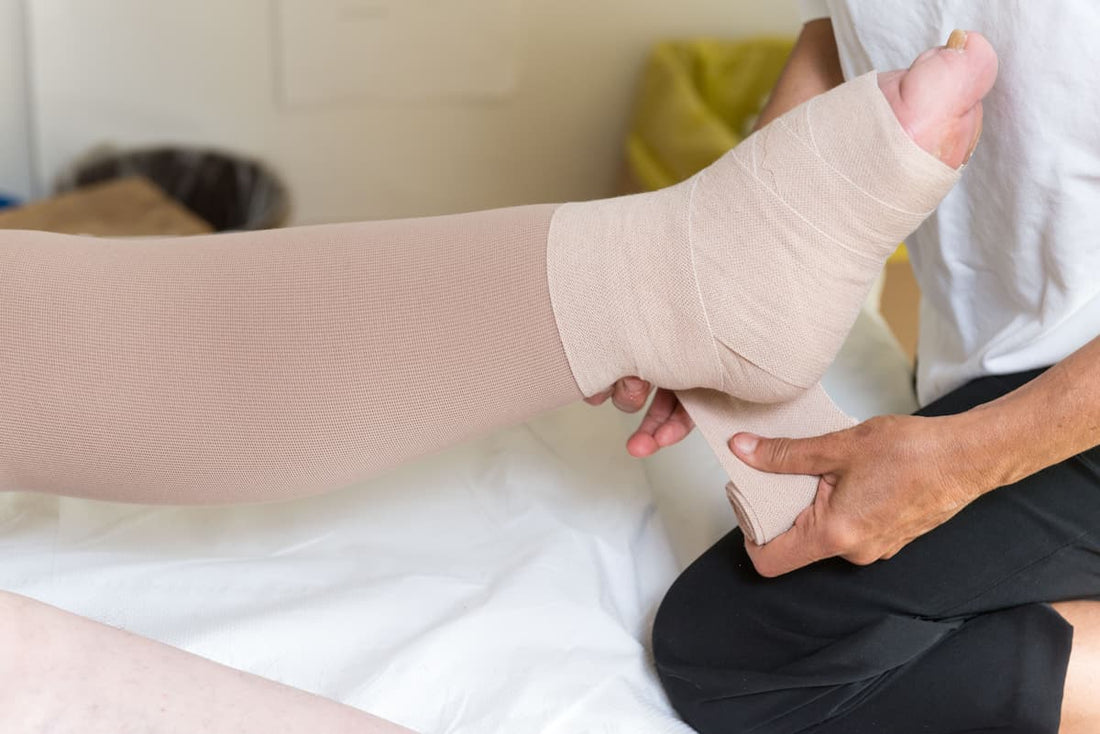It can be tough to know which type of compression product to choose when you have leg swelling. Here’s a look at the differences between elastic and inelastic compression.
What is compression therapy?
Compression therapy is a form of treatment that uses compression to improve circulation and reduce swelling. It is often used to treat leg swelling disorders like chronic venous insufficiency, lymphedema, and other medical conditions. Compression therapy can be done with devices such as compression socks and stockings, wraps, and bandages.
How does compression therapy work?
By squeezing the outside of the legs, compression helps to push fluid from the legs back up to the heart. This helps to reduce leg swelling and can also improve blood flow. Compression therapy can be done with different levels of compression.
But, in order for compression to be effective, it must be done consistently and often — especially if you're using static compression and you need to be on your feet and walking around.
What is the difference between elastic and inelastic compression?
There are different types of compression products that are useful in different situations – some are pulled up like a sock and some are rolled on as a bandage – but each product can be categorized on a scale of Elastic to Inelastic in terms of how stretchy the materials are.
Elastic compression products are made with materials that have some stretch, like spandex or latex. Examples include compression socks and hosiery. Elastic compression is best for conditions that don't involve open wounds or large amounts of swelling, like chronic venous insufficiency.

Inelastic compression products are made with materials that don't have any stretch, like nylon or polyester. Examples include compression bandages and wraps. Inelastic compression is best for conditions that involve open wounds or large amounts of swelling, like lymphedema, CVI, and ulcers.

Elastic vs inelastic compression: Which one is better for you?
There are pros and cons of each type of compression product. So, it's important to take a few things into consideration when choosing which product is best for you:
Elastic compression stockings can be difficult to apply, but bandages can be worse.
Compression socks and stockings are made with tight elastic — that's what makes them work — but it also makes them difficult for some users to put on. It also means they're not well-suited for wound care patients, as they cannot be easily pulled over wound dressings. On the other hand, some users may find compression bandages even harder to put on, as they require specific training to apply properly.
Inelastic is more comfortable at rest and more effective when walking around.
Elastic materials compress all the time, meaning that they can feel tight and pinch even when at rest. But when you walk around, they actually stretch, meaning that they can give up some of their compression, reducing the dynamic compression effect. Inelastic materials by comparison, are known to feel more comfortable at rest, and have much less stretch when walking around – this allows them to have comfortable supportive compression and effective dynamic compression.
Inelastic materials tend to last longer, elastic materials lose their effectiveness over time.
In general, elastic compression products are known to have shorter life spans because of “compression degradation”. One study showed that even with using a short-stretch bandage, there was a 51% compression loss within 24 hours.
On the other hand, inelastic compression products do not rely on elastic materials to apply compression and instead rely on a snug fit and non-stretch properties so they do not lose effectiveness over time.
However, depending on the design of the inelastic product, sometimes depending on the shape of the leg and user application, there can be “dead zones” where compression isn’t appropriately applied and when the swelling goes down the inelastic product needs to be reapplied to maintain compression.

Revolutionary Aero-Wrap™ makes advancements in inelastic compression.
The Aero-Wrap™ brings the benefits of inelastic compression forward to the next level. Unlike other inelastic products, compression is applied with air inflation that fills in the area around the leg, not by pulling crisscrossed straps. This means it requires less hand strength to put the product on – no tight elastic stocking or neoprene straps. Compression is dialed in with an AeroGauge™, allowing the user to easily customize, apply, adjust, and maintain compression.
As leg swelling reduces, instead of Aero-Wrap™ losing effectiveness like other compression products, one can simply adjust the compression throughout the day.
Aero-Wrap™ brings the best in an easy-to-apply system with inelastic air compression for all-day comfort and relief.
If you're considering compression products and are unsure whether elastic or inelastic is right for you, read the pros and cons above. If you still have questions, don't hesitate to reach out to us – we're happy to help! And if you're looking for a product that offers the best of both worlds, check out our revolutionary Aero-Wrap™ with inelastic air compression.

